Fair Labor Standards Act (FLSA) Facts & Worksheets
The Fair Labor Standards Act is the law that sets the hourly minimum wage a worker’s supposed to receive and the maximum number of hours per week he/she is required to work.
Search for Worksheets
Worksheets / Social Studies / US History / Fair Labor Standards Act (FLSA) Facts & Worksheets
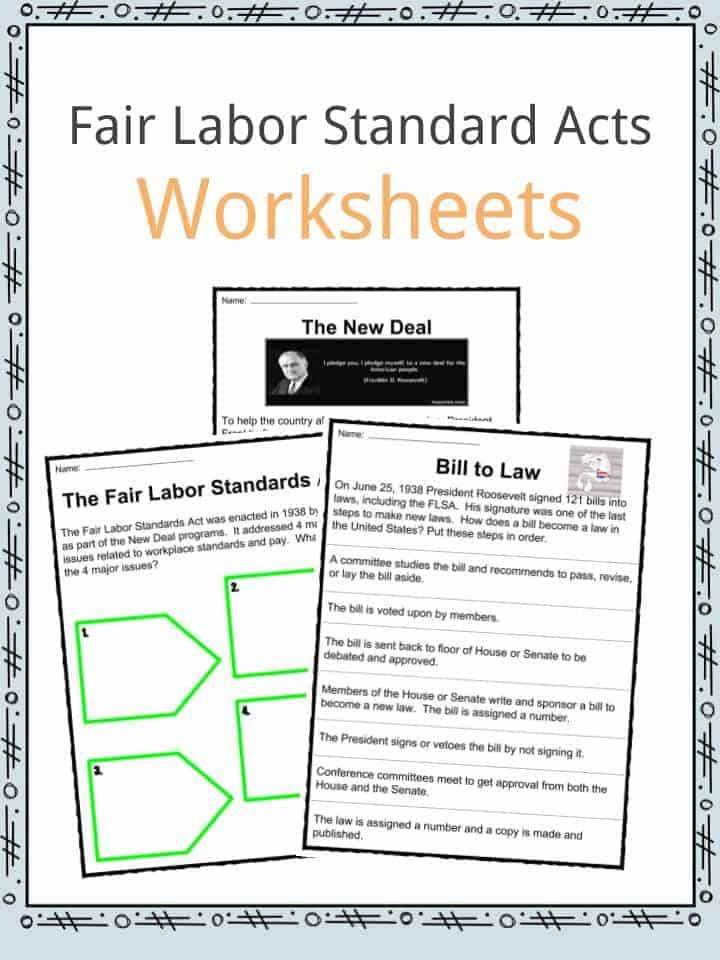
Download the Fair Labor Standards Act (FLSA) Facts & Worksheets
Click the button below to get instant access to these worksheets for use in the classroom or at a home.
Download This Worksheet
This download is exclusively for KidsKonnect Premium members!
To download this worksheet, click the button below to signup (it only takes a minute) and you'll be brought right back to this page to start the download!
Edit This Worksheet
Editing resources is available exclusively for KidsKonnect Premium members.
To edit this worksheet, click the button below to signup (it only takes a minute) and you'll be brought right back to this page to start editing!
This worksheet can be edited by Premium members using the free Google Slides online software. Click the Edit button above to get started.
Not ready to purchase a subscription? Click to download the free sample version Download sample
Download This Sample
This sample is exclusively for KidsKonnect members!
To download this worksheet, click the button below to signup for free (it only takes a minute) and you'll be brought right back to this page to start the download!
Table of Contents
The Fair Labor Standards Act is the law that sets the hourly minimum wage a worker’s supposed to receive and the maximum number of hours per week he/she is required to work. Additionally, it establishes overtime pay and record keeping as well as sets the principles for child labor. It was signed into law by US Pres. Franklin D. Roosevelt on June 25, 1938. Here are some interesting facts you may not know about the Fair Labor Standards Act or alternatively download our comprehensive worksheet pack to utilise within the classroom or home environment.
- Pres. Franklin Roosevelt was already set to propose laws bent on restricting child labor, putting boundaries on working hours and setting guaranteed minimum wages to workers at the start of his administration in 1933. It took five years of battle and a reelection to see that dream become a reality.
- Aside from the Fair Labor Standards Act of 1938, President Franklin Roosevelt signed 120 other bills on the same day. Why so many on just one day? He was trying to avoid pocket vetoes as Congress had adjourned 9 days earlier.
- The Fair Labor Standards Act of 1938, or FLSA for short, was born during the Great Depression.
- During the Great Depression, a great number of employees were subjected to difficult working conditions with very little pay and kids were driven to work like adults. Pres. Roosevelt wanted to end these problems with his New Deal program. The FLSA was the last part of this said plan.
- Under the New Deal program, the National Industrial Recovery Act [NRA] – a predecessor of the FLSA – was put into action. It even became very popular to the point where a couple from Pennsylvania named the new addition to their brood Nira in the act’s honor. But, the Supreme Court invalidated it over the “sick chicken” case, the Schechter Corp. v. United States case in May 27, 1935.
- The FLSA is also known as the Wages and Hours Act.
- The FLSA was described as “unconstitutional” and viewed as revolutionary in those times considering that it approved an hourly wage of only 25¢.
- Aside from the 25¢ per hour pay, The FLSA also approved a 44-hour work week and banned oppressive child labor.
- The law originally provided for a 40¢ per hour minimum wage. At the end, however, it was watered down to 25¢.
- Aside from the Congress, the US Supreme Court was one of the main blockers of wage-hour, child labor-related laws.
- One of the main reasons why a number of congressmen are against fair labor legislations during that time was because they didn’t like passing laws that give equal pay to black workers and white workers.
- However, Justice Owen Roberts voting in favor of a minimum wage law of Washington on March 29, 1937 changed the game. Justice Roberts’ vote was regaled as contemporary and “a switch in time saved nine.”
- The case where Justice Owens’ vote became a deciding turnaround was the West Coast Hotel Company v. Parrish case where Elsie Parrish, a former chambermaid of the Cascadian Hotel in Washington, charged the hotel company for not giving her the right earnings as what was specified in the state’s minimum wage law. Owens’ vote came to be known as the “Big Switch”. It’s a turning point in both American legal and social histories.
- The “Big Switch” was the encouragement fair legislations advocates needed to build up another bill that might have a greater chance of getting a nod from the Supreme Court.
- The FLSA was one of the two laws drafted by Labor Secretary Frances Perkins. The other one laid the ground for the Public Contracts Act of 1936, a law on minimum wage, hours of work and minimum age of employment applicable to government contractors.
- Alabama Senator Hugo Black, known then as a champion of the 30-hour work week, and Massachusetts Representative William P. Connery sponsored the draft made by Secretary Perkins – along with a host of lawyers close to Pres. Roosevelt – in the Senate and House respectively. Thus, it became the Black-Connery Bill.
- The Black-Connery Bill met a terrible fate, however. The House voted to have the bill sent back to Labor Committee Christmas of 1937. Secretary Perkins described the unfortunate event as “the first time that a major administration bill had been defeated on the floor of the House”. The press believed it was the death of wage-hour legislation and commented on how it was a direct blow against the President’s popularity.
- Roosevelt didn’t give up, however. Working on a new bill, he wanted this one short — only 2 pages. According to him, the length of the Black-Connery Bill made it complicated causing some of its difficulties. But Solicitor Labor Gerard Reilly couldn’t meet this required length. After some tweaks, they settled on 10 pages [from being 40 pages long!].
- That 10-page bill went through about 72 amendments before the Congress voted in favor of it. After more than a year, the FLSA passed the Congress and the Senate and ready for the President’s signature.
- Though signed in June 25, 1938, the law only became effective four months later — on October 30.
- Since it became a law, the FLSA has been changed and amended for at least 43 times.
Some of the most notable changes made on the FLSA are:
– 1946 – the functions of the Children’s Bureau and the responsibilities held by its chief were transferred to the Secretary of Labor.
– 1963 – this year, the Equal Pay Act was approved. This FLSA amendment states that a worker’s pay shouldn’t be based on his/her gender.
– 1966 – on this year, another amendment was made stating that an employee’s pay rate shouldn’t be based on age. This change was known as the Fair Labor Standards Amendment of 1966.
- The most notable FLSA revision was made in 1996. It was an adjustment to the minimum hourly wage raising it to $5.15. This amendment was named the Minimum Wage Increase Act of 1996 and was put into effect on September 1, 1997. From 25¢, the hourly rate came a long way!
Fair Labor Standards Act Worksheets
This bundle contains 11 ready-to-use The Fair Labor Standards Act Worksheets that are perfect for students who want to learn more about the Fair Labor Standards Act which is the law that sets the hourly minimum wage a worker’s supposed to receive and the maximum number of hours per week he/she is required to work.
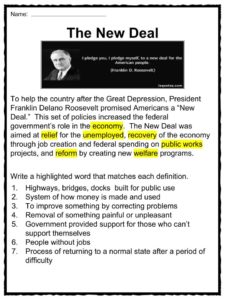
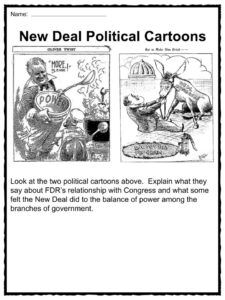
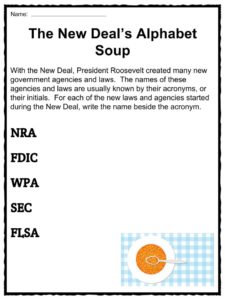
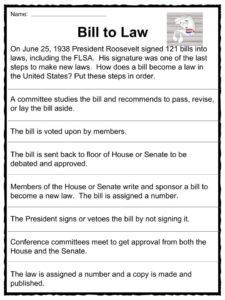
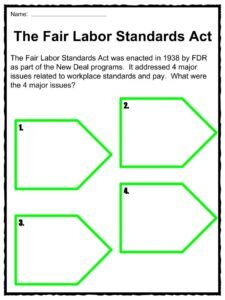
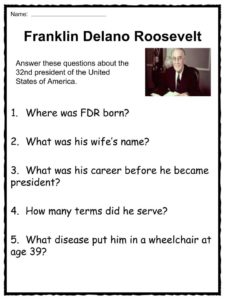
Complete List of Included Worksheets
- Facts
- The Great Depression
- Franklin Delano Roosevelt
- The New Deal
- New Deal Political Cartoons
- Alphabet Soup
- Bill to Law
- Black-Connery Bill to FLSA
- The Fair Labor Standards Act
- FLSA Amendments
- Fair Labor Standards
Link/cite this page
If you reference any of the content on this page on your own website, please use the code below to cite this page as the original source.
Use With Any Curriculum
These worksheets have been specifically designed for use with any international curriculum. You can use these worksheets as-is, or edit them using Google Slides to make them more specific to your own student ability levels and curriculum standards.








